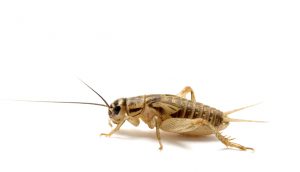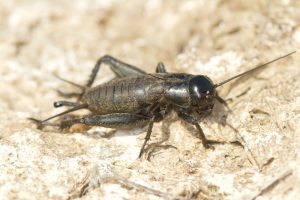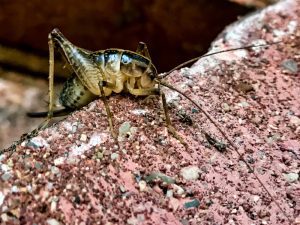GOT CRICKETS?
By Chris Williams on August 23, 2018.

House Cricket. Shutterstock
We’re approaching that time of year when crickets move indoors to escape conditions outside. In Massachusetts and New Hampshire, we have three different types of crickets that can be found indoors. The two most common invaders are the rather strange camel cricket (see “Jumping Spiders” Are Really Camel Crickets) and the almost black field cricket. The lighter-colored house cricket is less common, which is a good thing since it can live and reproduce indoors while the other two are generally just temporary visitors.

Field Cricket. Shutterstock.
FIELD CRICKETS OR CAMEL CRICKETS?
Of the two that we get the most calls about, the field cricket male is the only one that can chirp. That’s usually the biggest complaint about the presence of field crickets. Besides chirping, it flies and jumps well and is attracted to lights. The camel cricket, on the other hand, is blessedly quiet but freaks people out with its random high jumping. Any homeowner who has been invaded by camel crickets will not soon forget their presence. This creepy cricket has such long legs and long antennae that it is sometimes confused with a spider and is affectionately called a “spricket.”

Camel Cricket. Shutterstock
It doesn’t fly and is not attracted to lights, but along with the field and house crickets, it feeds on garbage and pet food and can damage fabrics, paper, leather, and rubber.
WHY DO CRICKETS MOVE INSIDE?
Crickets migrate indoors in response to the shorter days and somewhat cooler (we hope) temperatures of late summer into fall (see Crickets Can Move Indoors in Late Summer). A cricket’s outside food sources, including fruits, vegetables, other plants, and dead insects, are also disappearing. Crickets may also move inside in response to periods of drought or heavy rain. Field and house crickets can fly to outdoor lights at night and then find their way inside.
Once inside, the field cricket makes its general location known with its chirps but anyone who has tried to track down that maddening noise knows that it’s not that simple to find the cricket. Both field crickets and camel crickets are usually found in lower levels of a home where they hide during the day and are active at night. Typical sites for crickets are basements, ground floors, crawlspaces, garages, and sheds. Field crickets like warm, dark areas such as around hot water heaters or behind large appliances, while camel crickets prefer cool, damp, dark areas and can be found in places such as laundry rooms or shower stalls on lower levels. All crickets can be found around garbage and in or near boxed or stacked clothes, soiled rags, papers, or books stored in dark areas.
CALL COLONIAL NOW IF YOU WANT TO KEEP CRICKETS OUT!
Although field crickets and camel crickets don’t survive long-term indoors, they can survive long enough to be distressing. You can help keep them outside by managing woodpiles, mulch, weeds, garbage cans, and other materials that attract crickets to your foundation and by reducing outside lighting. Take steps now to block their access by having Colonial pest-proof and seal lower level and garage doors, vents, and other openings around the foundation. Our Preventative Maintenance Program includes a fall insecticide treatment around your foundation that will help to stop crickets and other fall-invading insects in their tracks. If they’re already inside, we can take care of that, too. Call Colonial today! 